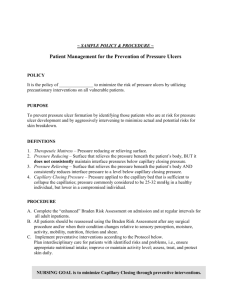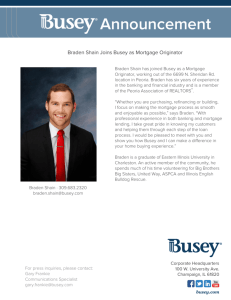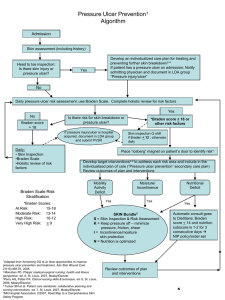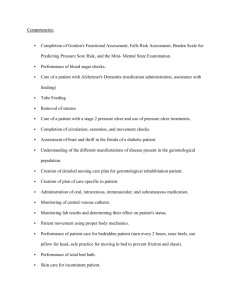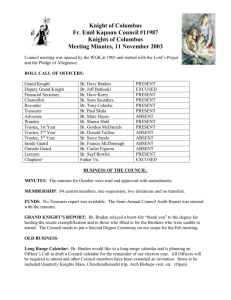Kelly, Barbara (1924 – 2007), performer and television personality
advertisement
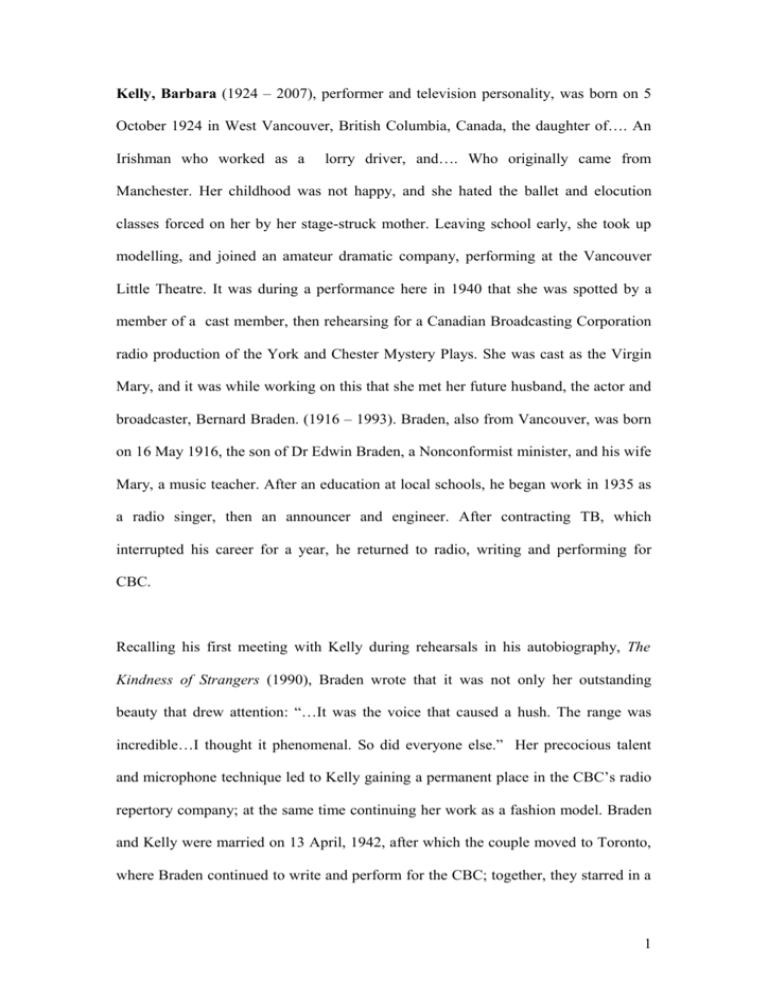
Kelly, Barbara (1924 – 2007), performer and television personality, was born on 5 October 1924 in West Vancouver, British Columbia, Canada, the daughter of…. An Irishman who worked as a lorry driver, and…. Who originally came from Manchester. Her childhood was not happy, and she hated the ballet and elocution classes forced on her by her stage-struck mother. Leaving school early, she took up modelling, and joined an amateur dramatic company, performing at the Vancouver Little Theatre. It was during a performance here in 1940 that she was spotted by a member of a cast member, then rehearsing for a Canadian Broadcasting Corporation radio production of the York and Chester Mystery Plays. She was cast as the Virgin Mary, and it was while working on this that she met her future husband, the actor and broadcaster, Bernard Braden. (1916 – 1993). Braden, also from Vancouver, was born on 16 May 1916, the son of Dr Edwin Braden, a Nonconformist minister, and his wife Mary, a music teacher. After an education at local schools, he began work in 1935 as a radio singer, then an announcer and engineer. After contracting TB, which interrupted his career for a year, he returned to radio, writing and performing for CBC. Recalling his first meeting with Kelly during rehearsals in his autobiography, The Kindness of Strangers (1990), Braden wrote that it was not only her outstanding beauty that drew attention: “…It was the voice that caused a hush. The range was incredible…I thought it phenomenal. So did everyone else.” Her precocious talent and microphone technique led to Kelly gaining a permanent place in the CBC’s radio repertory company; at the same time continuing her work as a fashion model. Braden and Kelly were married on 13 April, 1942, after which the couple moved to Toronto, where Braden continued to write and perform for the CBC; together, they starred in a 1 highly successful radio serial, John and Judy. In 1947, CBC sent Braden to Britain to make a series of documentaries on post-war recovery. It was a short working trip, but the material gathered for these programmes was to form the basis of a book, These English (1948). In 1949 he was back in the UK, this time with Kelly. The couple quickly established themselves as popular entertainers on stage and radio, their bright, lively personalities, attractive accents and warm humour endearing them to British audiences. Braden played the part of Harold Mitchell in Laurence Olivier’s production of A Streetcar Named Desire which opened at the Aldwich Theatre later the same year. Both Braden and Kelly were in demand separately in radio dramas, and Kelly became as a hit in the West End show, Male Animal, also in 1949. Although she appeared in a number of stage shows subsequently, she confessed that she never liked the medium, being much happier on radio and later, television. In May, 1949, the couple appeared in a one-off situation comedy about two Canadians living in London, called Leave Your Name and Number. The show was so successful that the BBC developed it as a full series, starting in April 1951. By this time Braden had established himself with the hugely successful Breakfast With Braden, a Saturday morning comedy and music series which first aired in January 1950. The format was preserved when the programme moved to an evening slot in September 1950, becoming Bedtime With Braden, when Bernard was joined by Barbara in the cast. In June of that year, the couple appeared on the cover of the Radio Times. Braden’s impact on British radio audiences of the time may be judged by an article in the 1951 edition of the BBC Handbook: “One of the more mobile, 2 quick-firing units in the current Canadian invasion of British entertainment is a oneman blitz named Bernard Braden…” “…So far nobody has explained whence Braden derives the energy that has rocketed him to stardom in only a year.” In 1951, the stillyoung BBC Television featured An Evening at Home with Bernard Braden and Barbara Kelly. Meanwhile Bedtime With Braden continued to run for a further four series, but in 1953 Kelly left the show to join the television panel game with which she was to become most associated, What’s My Line. By this time the Kelly had given birth to three children: a son, Christopher (born 1943, who predeceased her, dying of cancer, died ?…) Kelly (born?) … and Kim (born 1948). Chaired by Eamonn Andrews, and featuring panellists David Nixon, Gilbert Harding, Isobel Barnett and Kelly, the format was a simple one; members of the public would perform a short mime, from which the panel attempted to guess their occupation. Broadcast on Sunday evenings on the only television channel available until the launch of ITV in 1955, What’s My Line was almost compulsory viewing for those families possessing a television set. It ran until 1963, and in 1984 it was revived, running for a further three years, with Kelly and Andrews the only survivors of its most successful cast. During the early 1950s, Kelly also appeared in a number of films, among them A Tale of Five Cities (1951), Glad Tidings (1953) and Love in Pawn (1953). These were undistinguished works which however helped to subsidise the Bradens’ flamboyant lifestyle, with a large flat in Knightsbridge and a fine house in Hampstead. By the start of the 1960s, she was one of the best known personalities on British radio and television. Over the next decade, Kelly’s career was eclipsed as her husband’s moved into the 3 ascendancy. From 1962 – 68, Braden presented the programme for which he is best remembered, On the Braden Beat, for ATV. With this programme and its BBC successor, Braden created a new genre; the programme, a pioneering example of consumer television won a BAFTA award in 1964, and Braden himself became the Variety Club’s Personality of the Year in 1965. In 1968 he presented a BBC version in a similar format, Braden’s Week, which ran until 1972, when Braden was allegedly sacked by the BBC for presenting a margarine commercial on ITV. The broadcaster Esther Rantzen, a researcher on the show, later went on to present That’s Life, a television programme much like Braden’s Week in style and format. Although Rantzen always acknowledged her debt to Braden, Kelly remained bitter about the chain of events. From the 1970s onwards the careers of both Kelly and Braden were in decline; despite some further occasional radio, television and stage work, they were never again to reach the remarkable heights of popularity and public acclaim they had enjoyed during the 1950s and ‘60s. During this time they developed Adanac (Canada, spelt backwards) Productions, specialising in presentations at business conferences. Kelly started an agency offering advice on career development to celebrities and through her company Prime Performers, supplied the services of entertainers and broadcasters as after-dinner speakers. In May 1987 Kelly was operated on for throat cancer. This was successful although it left her face scarred and from this time she became more reclusive. In 1990 Braden published his memoir, The Kindness of Strangers, and in 1992 the couple celebrated their golden wedding anniversary. Despite being in poor health herself, Kelly nursed 4 her husband through a series of strokes. At the time of his death, in London on 2 February 1993, Braden was working on a second volume of autobiography. In 2000, Kelly set up a new company, Speakerpower, “specialising in personal training for everyone who has to speak in public”, and utilising the services of known successful broadcasters and performers as trainers. Kelly died in a Hampstead, London hospice, of cancer, on 15 January, 2007 at the age of 82. By the time of their deaths, radio and television trends had changed out of all recognition, and the last years of both Kelly and Braden were spent in relative obscurity. It is therefore important to remember what a remarkable influence they were on post-war British media over a period of nearly 30 years. Kelly, vivacious, charming, attractive, was a breath of fresh air and a household name on both radio and television. Braden should be remembered not only for his extreme versatility, but for his major contribution to broadcasting in pioneering consumer television. SEÁN STREET Sources The Guardian (4 February 1993). The Independent (6 February, 1993)The Daily Telegraph (16 January 2007). The Independent (16 January 2007). The Guardian (17 January 2007). BBC Year Book (1951). B. Braden, The Kindness of Strangers, (1990). A.Briggs, The History of Broadcasting in the united Kingdom, Vol V, Competition 1955-1974, (1995). A.Foster & S. Furst, Radio Comedy 1938 – 1968, (1996). D. Gifford, The Golden Age of Radio (1985). S.Street The Historical Dictionary of British Radio (2006) 5 Archives TELEVISION BFI NFTVA, Performance footage. BFI NFTVA, Documentary footage, SOUND, BL SA. performance recordings, Paper, BBC WAC. Likenesses Photographs, repro. In B. Braden, The Kindness of Strangers(1990). 6
